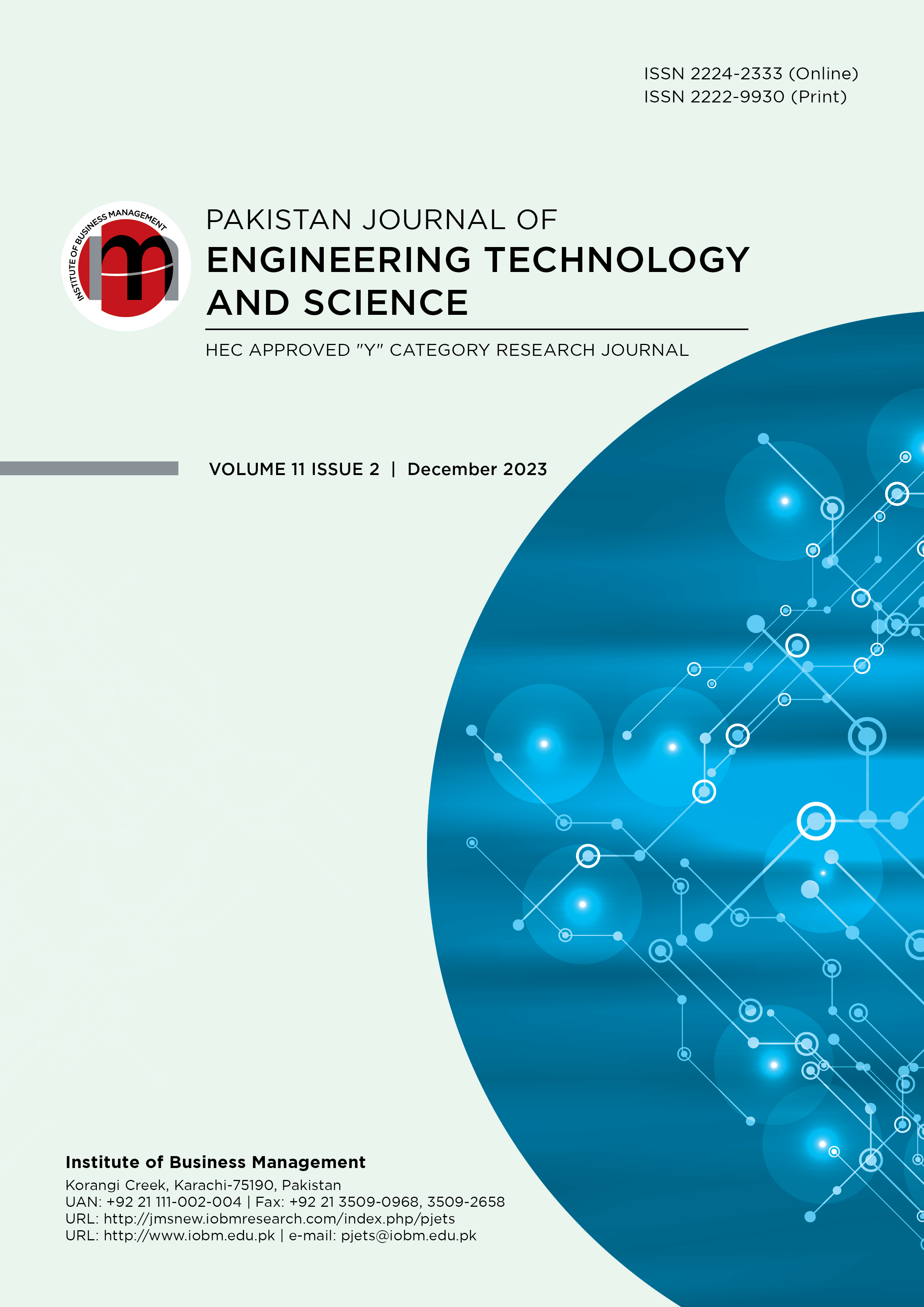Issues of Pakistan Journal of Engineering, Technology, and Sciences (PJETS)
Journal
Pakistan Journal of Engineering, Technology, and Sciences (PJETS)
Editor
Umme Laila
Publisher
Institute of Business Management
ISSNP
2222-9930
ISSNE
2224-2333
Frequency
Biannual
Article Processing Charges
Rs. 10000/-
Submission Charges
None
Journal Start Date
2011
Review Process
Double Blind Peer Review
Subjects
Computer Science; Mathematics; Engineering
Languages
English
Editorial Board URL
https://jmsnew.iobmresearch.com/index.php/pjets/Aims-and-Scope
Author Instructions URL
https://jmsnew.iobmresearch.com/index.php/pjets/Aims-and-Scope
Author Licence URL
https://jmsnew.iobmresearch.com/index.php/pjets/Aims-and-Scope
Open Access
Yes
ARI Id
349
This page has been accessed 208 times.
Introduction
he Pakistan Journal of Engineering, Technology, and Sciences (PJETS) has been recognized as a "Y-Category" journal by the Higher Education Commission (HEC) of Pakistan published by Institute of Business Management (IoBM). It is a double-blind peer-reviewed, bi-annual, open-access journal of the College of Computer Science & Information Systems(CCSIS). PJETS considers manuscripts that demonstrate scientific excellence and significance in relation to its main theme. Submitted papers should report original, rigorously validated research, including a thorough description of the experimental methods used.
It was established in 2011 and covered the areas of Engineering Sciences, Computer sciences, and Mathematics Sciences. This journal aims to provide an international platform for engineers and academicians worldwide to promote, share, and discuss various new issues and developments.
The paper submission process is automated by an Open Submission System (OJS), facilitating the authors, editors, and reviewers. Editorial Research Board members are from various universities/institutes in the USA, UK, Netherlands, Malaysia, Canada, France, Finland, UAE, and others.
Aims and Scope
Aims
PJETS Research Journal will publish and solicit genuine and novel work on contemporary trends in the incipient domains of science and engineering technologies. PJETS will be aiming to
To provide a platform to researchers and academicians for bringing innovative research ideas from diverse disciplines of engineering and science.
To give scholars a chance to be part of the scholars’ community who assists and helps others in publication and review
To promote research by disseminating research ideas at affordable or at no cost in long run
To upkeep a platform for researchers, in alignment with HEC’s objectives of creating research-culture in higher education institutions
To bridge the academia-industry gap for socio-economic development.
Scope
The PJETS scopes the wide range of topics within domain of Computer Science, Computer Engineering, Physical Sciences and Technology. Authors are encouraged to submit complete unpublished and original works, which are not under review in any other journals. The scopes of the journal include, but not limited to, the following topic areas:
Computer Science
Big Data Analytics
Data Mining and Data Ethics
Artificial Intelligence
Pervasive computing and Cloud Computing
Computer Vision
Blockchain Technology,
Internet of Things.
Mathematic Sciences
Mathematical Modeling,
Algorithms,
Probability Theory,
Operations Research,
Econometrics,
Mathematical Analysis,
Dynamical Systems,
Simulation and Modeling,
Numerical Analysis.
Energy Science and Technology
Applied Physics
Quantum Science and Computing
Green Sustainable Science and Technology.
Engineering Sciences
Computer Engineering
Systems Engineering
Software Engineering
Web Engineering
Digital Signal Processing
Embedded Systems
Fuzzy Logic
VLSI
Wireless Communication and Sensor Networks
Robotics
Mobile Communication
Contact Information
Dr. Umm-e-Laila
Phone
+92-21-111002004 (Ext 339)
pjets@iobm.edu.pk
Additional Information
With respect to the similarity index, PJETs has 0% tolerance. The "Turnitin" plagiarism detection software is used to scan the submitted papers (HEC). "Turnitin" is HEC approved plagiarism software. The submitted paper is returned if the plagiarism of the article is more than the acceptable ratio for revision.
For more details please refer to the Publication Ethics of the journal. The paper after the plagiarism check is send for the double-blind peer-review process. As per HEC rules, one reviewer in a double-blind peer review procedure must to be an international expert.
The papers are published under the Creative Commons Attribution 4.0 International (CC BY 4.0) license.
| Volume & Issue | Year | No of Articles |
| Volume & Issue | Year | No of Articles |
